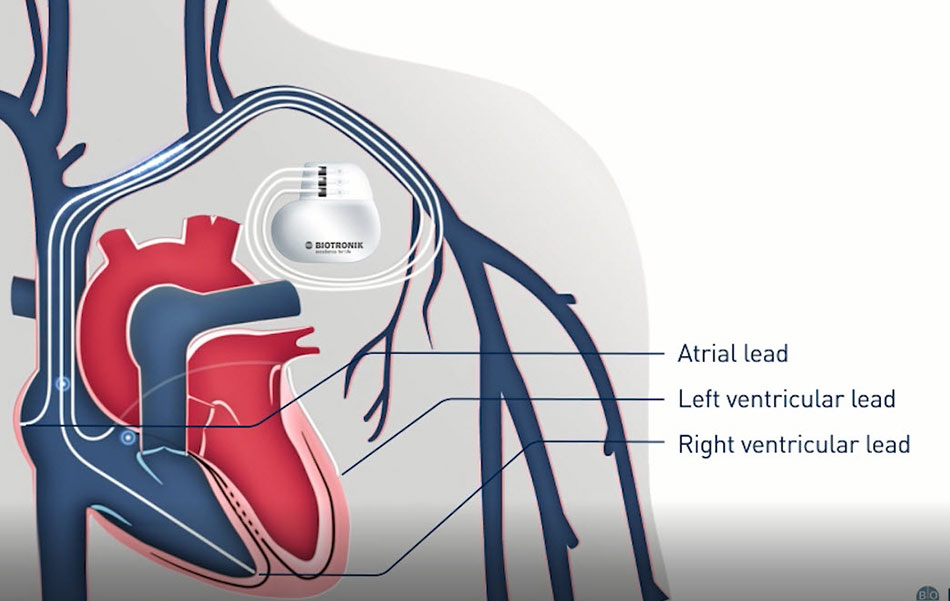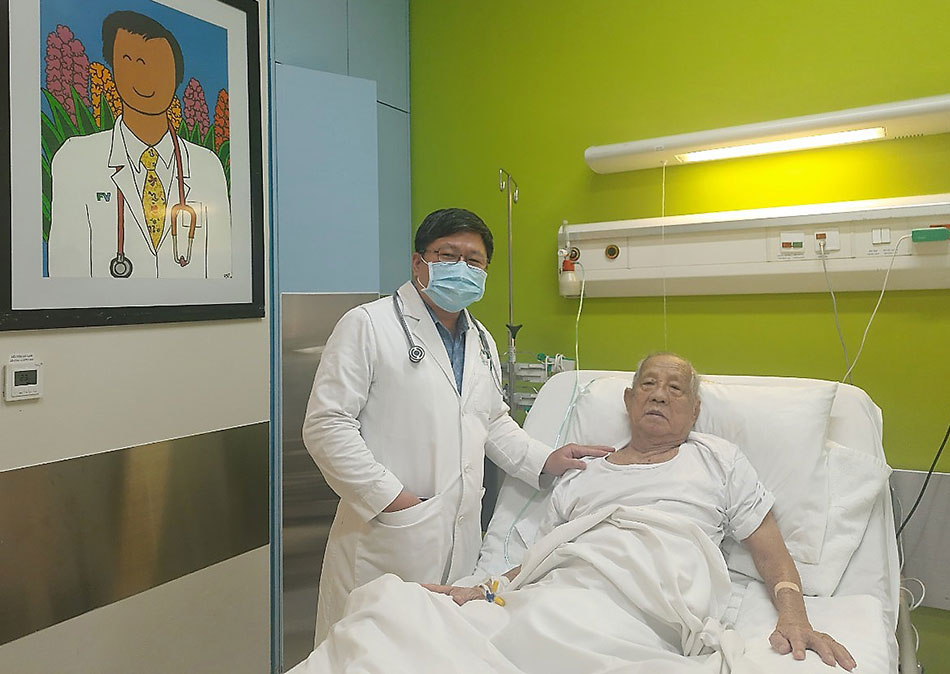For many years Mr P.D.T. (88 years old, HCMC) suffered from heart failure and often experienced fatigue, shortness of breath and chest pain. He was regularly hospitalised because his condition was so severe that he required a ventilator. However, the development of modern medical techniques has provided Mr T. a better solution to living with his condition and a better quality of life.
Working hard to find the best solution
Ms H., Mr P.D.T.’s daughter, shares that he was diagnosed with heart failure more than five years ago. Around that time, Mr T.’s health gradually deteriorated and he needed regular care from his family members and frequent hospital check-ups. Mr T. was admitted for several days every one to two months when he felt short of breath or had a bout of fatigue, and often needed a ventilator. This situation recurred for many years as there was no better treatment available to him.
Prior to his last admission to FV Hospital in mid-January 2022, Mr T.’s heart failure had become more serious. He was unable to move unassisted and unfortunately was at a high risk of death. During Mr T.’s observation in the intensive care unit (ICU), Dr Quang Minh reviewed his entire medical record while studying his history of heart failure in the hope of finding a more satisfactory solution.
Dr Hoang Quang Minh (Department of Cardiology, FV Hospital) said that Mr T. was suffering from very severe heart failure, deemed to be level IV on the New York Heart Association (NYHA)’s four-level classification scale. “For such severe cases of heart failure, usually only a heart transplant is indicated. But because the likelihood of finding a replacement heart is very low, medication was our only option to maintain the patient’s life,” says Dr Minh.
While many cardiovascular diseases can lead to heart failure, Mr T. was determined to have hypertrophic cardiomyopathy, a disease when the heart wall muscle is thicker than normal, thereby reducing its ability to contract and reduce the volume of blood in the heart chambers. The disease also leads to conduction disturbances (left bundle branch block) and reduces the ejection capacity of the heart to less than 50 per cent. However, according to Dr Minh, this is the required condition for doctors to being able to assign a three-chamber cardiac resynchronisation machine (CRT) to treat the patient. Previously, Mr T’s heart failure condition did not meet the requirements for doctors to prescribe this technique. “This option may be the most appropriate solution at this time to save lives and provide a better quality of life for patient Mr T.,” adds Dr Minh

Indication of placing a three-chamber cardiac resynchronisation machine (CRT) is the most appropriate solution for Mr P.D.T.
Technological developments in medicine can improve a patient’s quality of life
The procedure of placing a three-chamber cardiac resynchronisation machine (CRT) at FV is performed in the modern Cardiac Catheterisation Laboratory (CathLab), where the process can be carried out accurately, quickly and with a high degree of infection safety control. Because the CRT device is paced with the heart’s natural beating mechanism, the challenge in operating the CRT device is optimising the machine. Doctors, in addition to performing the correct insertion procedure, need to carefully calibrate the device to be compatible with the patient’s current heart rate, avoiding arrhythmias.
Accordingly, the machine has three conduction wires: two pacing wires connected from the machine to the left ventricle and right ventricle, and a receptor wire that connects to the atria to receive rhythm signals produced by the heart. When receiving the signal, the sensor wire will notify the machine, which will send a transmission to the two ventricles to create a beat, so that the time between the natural heartbeat and the beat generated by the CRT machine is exactly 40 milliseconds (0.04 seconds). This creates synchronisation with the patient’s current heart rate, helping the heart to maintain an optimal beat rate.

The patient’s health has improved markedly after installing a CRT pacemaker.
After implanting a three-chamber pacemaker, Mr T. was monitored and assessed for compatibility with the device’s operation for a period of 30 days, before being discharged. Ms H. said: “I see that my father’s health has improved significantly since being fitted with the device. When the machine became compatible with his body, my father’s situation improved even further and he no longer needed a ventilator.”
Mr T’s family has a great deal of confidence in the post-operative care process at FV. This has helped the patient’s recovery: FV’s team can provide psychological support to Mr T. and his family members while minimising possible complications during the postoperative period.
The solution of implantation helps patients move from heart failure level IV (according to the NYHA scale) to heart failure level III, i.e. from very severe to severe. Dr Hoang Quang Minh said that the patient, who had limited mobility and needed constant care, is now able to walk and live on his own, greatly improving his quality of life. The treatment team has achieved its goal thanks to the development of medical technology.

Dr Hoang Quang Minh has more than 10 years of experience treating cardiac arrhythmias with electrophysiological methods, ablation and pacing
FV Hospital’s Cardiology Department is equipped with state-of-the-art synchronic tools and technologies and is staffed by a highly experienced team of doctors. The Cardiology team is always ready to provide advanced diagnostic and comprehensive treatment plans, including prevention methodologies, early screening and diagnosis, treatment and cardiac rehabilitation.
Since May 2018, FV Hospital has operated its Interventional Catheterisation Laboratory (Cathlab). The Interventional Catheterisation Laboratory (Cathlab) received more than US$ 1.6 million of investment for its system of modern machines and equipment to best aid doctors with diagnosis and treatment of dangerous diseases. The conditions treated here include: heart attacks, blockages of blood vessels, aortic aneurysm and valve incompetence.
Dr Hoang Quang Minh is a senior doctor at the Cardiology Department, FV Hospital. Dr Minh has more than 10 years of experience in the treatment of cardiac arrhythmias with electrophysiological methods, ablation and pacing.
To make an appointment and to learn more, please contact the Cardiology Department: (028) 5411 3467 or (028) 5411 3333 Ext: 1216 / 1165.



